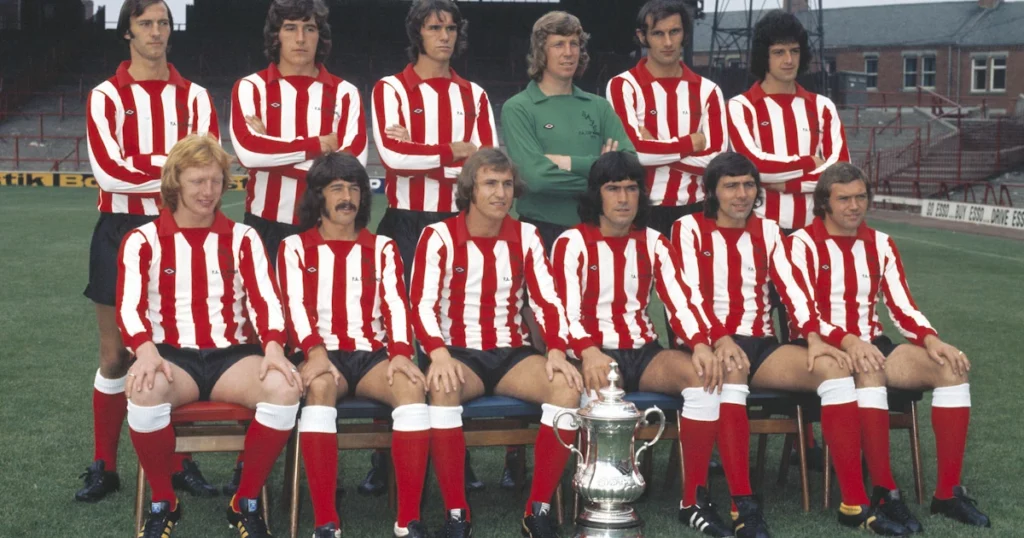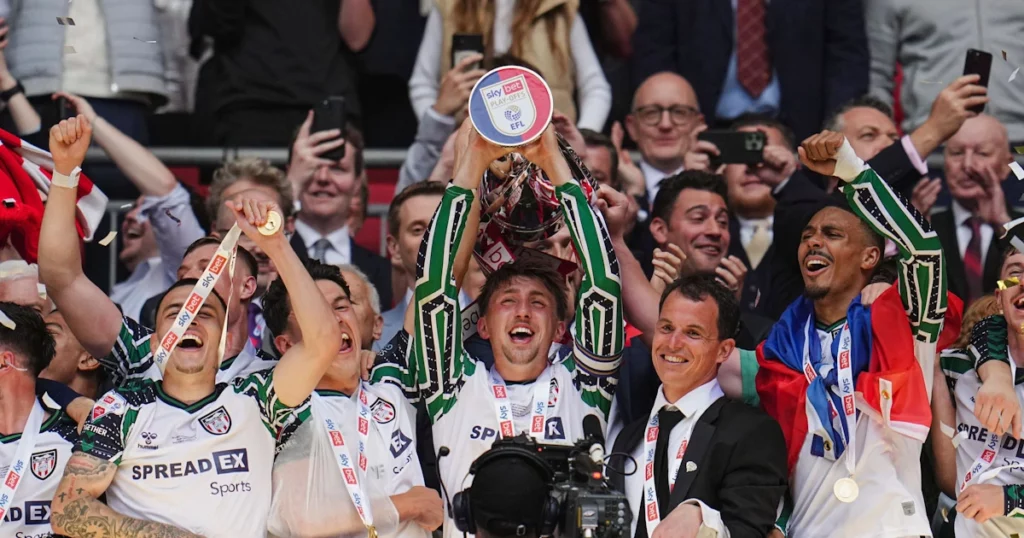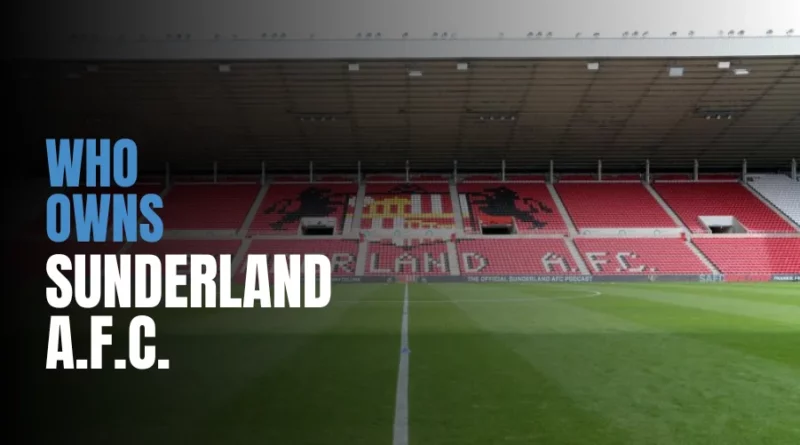Who is the Sunderland A.F.C. Owner? A Detailed Timeline of the Sunderland Ownership History
Sunderland Association Football Club, affectionately known as “The Black Cats,” boasts a truly remarkable history stretching back to its formation in 1879. Founded by schoolmaster James Allan, the club quickly established itself as a powerhouse in English football’s early days. Let’s dive deep into the history of the Sunderland owner. Joining the Football League in the 1890-91 season, Sunderland wasted no time making their mark, achieving League Championship glory just one season later. This rapid ascent led William McGregor, the league’s founder, to famously dub them “The Team of All Talents” after a resounding 7-2 victory against Aston Villa. In this article, we will answer the most discussed question among Sunderland fans: who owns Sunderland?
The club’s trophy cabinet gleams with six top-flight titles, secured in 1892, 1893, 1895, 1902, 1913, and 1936. They also boast two FA Cup triumphs in 1937 and 1973, in addition to winning the FA Charity Shield in 1936. Sunderland is more than just a football club; it is a fundamental part of the identity of Tyne and Wear. The Stadium of Light, with its 49,000 capacity, stands as a testament to the fervent loyalty of its “Mackem” supporters, consistently boasting high attendance rates even when the club has found itself in lower divisions.
Throughout its long and storied journey, the club’s trajectory, for better or worse, has been intrinsically linked to those who have held the reins. Decisions made by the various owners, their financial strategies, and their leadership styles have all left an indelible mark on Sunderland’s legacy, shaping its successes, helping it endure challenges, and profoundly influencing its deep connection with the community.
The club’s history demonstrates a recurring pattern of significant highs and lows, with financial management often playing a pivotal role in these cycles. This enduring fan loyalty means that any ownership, past or present, operates under immense public scrutiny and carries a heavy responsibility to the community, making fan sentiment a crucial aspect of their impact. Even the new Sunderland owner has to go through this scrutiny.
Also Read: Who is the Newcastle United owner? A Detailed Timeline of the Newcastle United Ownership History
Club History: From Humble Beginnings to “The Team of All Talents”

The foundational story of Sunderland AFC begins in 1879, when schoolmaster James Allan established the “Sunderland & District Teachers A.F.C.” His initial vision was simple yet profound: to provide “recreational amusement” for the area’s schoolteachers, thereby laying the groundwork for what would eventually become a footballing giant. The club officially formed on September 25, 1880, and quickly expanded beyond its teacher-only origins, soon becoming known simply as Sunderland A.F.C.
A pivotal moment in the club’s early development occurred in 1885 when Sunderland turned professional. This transition saw them recruit several talented Scottish players, marking the arrival of their first internationally capped individuals. The club’s founder, James Allan, departed in 1888 due to his opposition to this growing professionalism, a philosophical split within the club’s early leadership that led to the subsequent formation of Sunderland Albion. This early internal conflict over the club’s direction foreshadowed future challenges related to commercialization and financial management.
Sunderland’s entry into The Football League for the 1890-91 season was a significant step, and under manager Tom Watson, appointed in 1888, they swiftly achieved league championship glory in the 1891-92 season. This rapid success led William McGregor, the league’s founder, to famously call them the “Team of All Talents” after a resounding 7-2 victory against Aston Villa.
They successfully defended their title in 1892-93, becoming the first team to score 100 goals in a season, a feat driven by Scottish centre-forward John Campbell’s prolific scoring. After finishing second in 1893-94, they reclaimed the title in 1894-95, with Campbell again as top scorer. The club moved to Roker Park in 1898, which would serve as their home for nearly a century, eventually holding over 75,000 fans at its peak.

The iconic 1973 FA Cup triumph, a 1-0 victory over Don Revie’s formidable Leeds United while Sunderland was still a Second Division club, remains particularly legendary. This victory was largely due to goalkeeper Jimmy Montgomery’s heroic saves and Ian Porterfield’s decisive goal. This achievement was a rare feat, with only two other clubs matching it since, underscoring its significance.
Early financial irregularities, such as the “McCombie affair” in 1904, where directors were suspended and the club fined for improper payments to a player, indicate that financial oversight and integrity have been recurring themes in Sunderland’s history, predating the modern era. This suggests a historical vulnerability to financial mismanagement or questionable practices that would, unfortunately, resurface later.
A Rollercoaster Ride: The History of Sunderland Owner
The biggest question that comes up is, who is the new Sunderland owner? Sunderland’s ownership history is as dramatic as its on-pitch battles, with each era bringing its challenges and successes. Here’s a detailed timeline of previous Sunderland Owner, supported by various sources, of the Sunderland owner.
| Owner/Ownership Group | Period | Key Highlights/Impact |
| James Allan (Founder) | 1879-1888 | The previous Sunderland owner before the current regime. Performances par. |
| Early Club Boards | 1885~1900s | Significant spending on transfers, financial scandal (1957), leading to the first relegation. |
| “Bank of England Club” Era | 1945-1959 | Founded a club in, early amateur years, departed due to “professionalism.” |
| Various Chairmen/Boards | 1959-2006 | FA Cup glory (1973), promotions/relegations, move to Stadium of Light (Bob Murray as Chairman from 1987). |
| Drumaville Consortium | 2006-2008 | Takeover, appointment of Roy Keane as manager. |
| Ellis Short | ~2008-2016 | Significant ownership period, mixed performances without much success. |
| Stewart Donald | 2016-2021 | The current majority (Louis-Dreyfus 64%) and minority (Sartori 36%) owners focus on youth, sustainability, and infrastructure. |
| Kyril Louis-Dreyfus & Juan Sartori | 2021-Present | The previous Sunderland owner before the current regime. Performances par. |
- The Early Years & Professionalism (1879 – early 1900s): In its nascent stages, Sunderland AFC, like many clubs of its era, did not have “owners” in the contemporary sense. Its foundation by schoolmaster James Allan and the subsequent decision to turn professional in 1885 marked the initial shifts in control and financial structure. The departure of founder James Allan in 1888, driven by his strong dislike for the “professionalism” creeping into the club, highlights an early philosophical split within the club’s leadership. This event, leading to the formation of Sunderland Albion, demonstrates how fundamental disagreements over the club’s identity and financial direction emerged very early on. Early financial issues also surfaced, notably the “McCombie affair” in 1904. In this incident, the club’s board was found to have given right-back Andy McCombie £100 to start a business, which was later deemed a “resigning/win/draw bonus” by the Football Association. The club faced a £250 fine, and six directors were suspended for two and a half years due to further breaches of financial rules. This incident reveals a recurring pattern of financial ambition and, at times, questionable financial management throughout Sunderland’s history.
- The “Bank of England Club” Era & Post-War Challenges (1945 – 1995): The period immediately following World War II saw Sunderland earn the distinctive nickname “The Bank of England club.” This moniker was a direct result of their significant spending on player transfers, including record fees for talents like Ivor Broadis, Len Shackleton, and the Welsh international Trevor Ford. This era was characterized by substantial financial outlay in pursuit of success, reflecting an ambitious, albeit sometimes reckless, approach to club management. However, this spending spree was not without its pitfalls. A major financial scandal erupted in 1957 when the club was found guilty of making payments to players that exceeded the maximum wage. As a consequence, Sunderland was fined £5,000, and its chairman and three directors were suspended. This scandal had immediate and severe on-pitch consequences: the following year, Sunderland was relegated from the highest division for the first time in its 68-year league history. They achieved promotion back to Division One in 1964 and famously won the FA Cup in 1973 as a Second Division club. Another FA Cup final appearance came in 1992, again as a Second Division side, though they ultimately lost to Liverpool. A unique promotion occurred in 1990: after losing the play-off final to Swindon Town, Sunderland was promoted instead when Swindon’s promotion was revoked due to financial irregularities, highlighting that financial issues were not unique to Sunderland but affected other clubs as well.
- The Modern Era & Stadium Shift (1995 – 2006): The mid-1990s marked a period of significant structural change for Sunderland. Under new chairman Bob Murray and manager Denis Smith, the club achieved promotion in the 1989-90 season. Peter Reid was appointed manager in 1995, a tenure that lasted until 2002. This period saw the monumental move from Roker Park, their home for nearly a century, to the new, state-of-the-art Stadium of Light in 1997. This relocation represented a huge step for the club’s infrastructure and capacity, reflecting a strategic vision for growth and modernization.
- The Drumaville Consortium & Ellis Short (2006 – 2016): In 2006, the Drumaville Consortium took over the club, ushering in a new era of ownership. A notable early decision of this consortium was the appointment of Roy Keane as manager in September 2006. Following this period, Ellis Short became a prominent figure in Sunderland’s ownership, with his era extending until 2016. While the provided information does not extensively detail the specific impact of Short’s tenure, his ownership marked a significant chapter in the club’s recent history.
- The Stewart Donald Years (2016 – 2021): Stewart Donald acquired a controlling stake in Sunderland in 2016. His ownership period was characterized by significant challenges and, ultimately, led to Kyril Louis-Dreyfus’s acquisition of a “controlling” stake in February 2021.
Also Read: Nottingham Forest Owner: Who Owns Nottingham Forest Club?
The Kyril Louis-Dreyfus Era: A New Chapter Unfolds

As of May 2025, Kyril Louis-Dreyfus and Juan Sartori are the new owners of Sunderland, with Louis-Dreyfus owning 64% and Sartori 36%. Louis-Dreyfus, born in 1997, became involved in February 2021, initially with a 41% stake. Sartori, a Uruguayan businessman, joined in 2018 and increased his stake alongside Louis-Dreyfus later.
By May 2023, Louis-Dreyfus further solidified his control, raising his shares to 64%, while Juan Sartori’s stake rose to 36%, effectively ending Stewart Donald’s direct involvement. This consolidation of ownership was largely welcomed by supporters, signaling a clearer direction for the club. The strategic vision under Louis-Dreyfus is centered on investing in young talent and providing them with opportunities, marking a clear departure from some previous approaches.
Their impact has been transformative. Focusing on a sustainable model, they’ve invested in youth development, with sporting director Kristjaan Speakman playing a key role. This strategy paid dividends with promotion from League One in the 2021-2022 season, followed by competitive Championship campaigns, including play-off appearances. In 2025, Sunderland won promotion to the Premier League via the play-offs, marking a significant milestone.
Fans generally support the Sunderland owner approach, appreciating the long-term vision, though some call for more spending on established stars. Community engagement, like initiatives at the Stadium of Light, has also boosted goodwill.
The Current Ownership Situation: A Fan’s Perspective

The owners have actively intervened in the club’s finances. They notably cleared an £8.2 million overdraft using a “working capital facility” from a Louis-Dreyfus family entity. This demonstrates a direct financial commitment and support, which is a positive sign for stability. From a fan’s perspective, this era is characterized by a blend of cautious optimism, lingering frustrations, and a yearning for the club to reclaim its former glory.
The strategic investments in infrastructure, youth development, and a modern footballing structure lay a strong foundation for future, sustainable success. The club is positioned to “capitalise on its investments” and “elevate Sunderland’s regional economic impact” upon a potential Premier League return.
However, the financial realities of competing in the Championship, coupled with the ongoing need to manage fan expectations and fully address the lingering questions about financial structures, remain critical challenges that will continue to shape the narrative of their tenure. Although the current promotion of Sunderland AFC in this season of 2024/25 back to the Premier League for the next season 2025/26 is showing progress, and the fans are appreciating it.
FAQs
Who is the current majority owner of Sunderland AFC?
Kyril Louis-Dreyfus is the current majority owner and Chairman of Sunderland AFC, holding a 64% stake. Juan Sartori holds the remaining 36%.
What is the “Bank of England club” nickname in Sunderland’s history?
The nickname “The Bank of England club” was given to Sunderland AFC in the immediate post-World War II years (1945-1959). This was due to their significant spending on player transfers, including record fees for players like Ivor Broadis, Len Shackleton, and Trevor Ford.
What major trophies has Sunderland AFC won throughout its history?
Sunderland AFC has won six top-flight league titles (1891–92, 1892–93, 1894–95, 1901–02, 1912–13, 1935–36) and two FA Cups (1937, 1973). They also secured the FA Charity Shield in 1936 and the Sheriff of London Charity Shield in 1903.
How do Sunderland fans generally feel about the current ownership?
Fan sentiment towards the current ownership is mixed. While there is appreciation for the focus on youth development, rebuilding club infrastructure, and a commitment to long-term sustainability, initial concerns arose from the perceived lack of transparency regarding Kyril Louis-Dreyfus’s initial minority stake. The ongoing delay in converting owner loans to equity also causes some concern among supporters, who desire full ownership consolidation and quicker promotion to the Premier League.
Has Sunderland won any trophies under the current ownership?
While no major trophies yet, they’ve achieved promotions and play-off success, including the 2025 Premier League return, showing progress.
